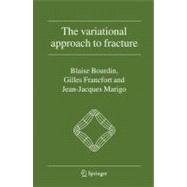
The Variational Approach to Fracture
by Bourdin, Blaise; Francfort, Gilles A.; Marigo, Jean-jacques-

This Item Qualifies for Free Shipping!*
*Excludes marketplace orders.
Rent Textbook
Rent Digital
New Textbook
We're Sorry
Sold Out
Used Textbook
We're Sorry
Sold Out
How Marketplace Works:
- This item is offered by an independent seller and not shipped from our warehouse
- Item details like edition and cover design may differ from our description; see seller's comments before ordering.
- Sellers much confirm and ship within two business days; otherwise, the order will be cancelled and refunded.
- Marketplace purchases cannot be returned to eCampus.com. Contact the seller directly for inquiries; if no response within two days, contact customer service.
- Additional shipping costs apply to Marketplace purchases. Review shipping costs at checkout.
Summary
Table of Contents
| Introduction | p. 1 |
| Going variational | p. 9 |
| Griffith's theory | p. 10 |
| The 1-homogeneous case - A variational equivalence | p. 14 |
| Smoothness - The soft belly of Griffith's formulation | p. 18 |
| The non 1-homogeneous case - A discrete variational evolution | p. 21 |
| Functional framework - A weak variational evolution | p. 22 |
| Cohesiveness and the variational evolution | p. 27 |
| Stationarity versus local or global minimality - A comparison | p. 31 |
| 1d traction | p. 31 |
| The Griffith case - Soft device | p. 31 |
| The Griffith case - Hard device | p. 33 |
| Cohesive case - Soft device | p. 34 |
| Cohesive case - Hard device | p. 38 |
| A tearing experiment | p. 42 |
| Initiation | p. 47 |
| Initiation - The Griffith case | p. 48 |
| Initiation - The Griffith case - Global minimality | p. 48 |
| Initiation - The Griffith case - Local minimality | p. 55 |
| Initiation - The cohesive case | p. 58 |
| Initiation - The cohesive 1d case - Stationarity | p. 58 |
| Initiation - The cohesive 3d case - Stationarity | p. 61 |
| Initiation - The cohesive case - Global minimality | p. 67 |
| Irreversibility | p. 70 |
| Irreversibility - The Griffith case - Well-posedness of the variational evolution | p. 70 |
| Irreversibility - The Griffith case - Discrete evolution | p. 70 |
| Irreversibility - The Griffith case - Global minimality in the limit | p. 74 |
| Irreversibility - The Griffith case - Energy balance in the limit | p. 78 |
| Irreversibility - The Griffith case - The time-continuous evolution | p. 80 |
| Irreversibility - The cohesive case | p. 83 |
| Path | p. 90 |
| Griffith vs. Barenblatt | p. 103 |
| Numerics and Griffith | p. 107 |
| Numerical approximation of the energy | p. 108 |
| The first time step | p. 109 |
| Quasi-static evolution | p. 114 |
| Minimization algorithm | p. 115 |
| The alternate minimizations algorithm | p. 116 |
| The backtracking algorithm | p. 117 |
| Numerical experiments | p. 119 |
| The 1D traction (hard device) | p. 119 |
| The tearing experiment | p. 122 |
| Revisiting the 2D traction experiment on a fiber reinforced matrix | p. 132 |
| Fatigue | p. 135 |
| Peeling evolution | p. 137 |
| The limit fatigue law when d [characters not reproducible] 0 | p. 139 |
| A variational formulation for fatigue | p. 147 |
| Peeling revisited | p. 147 |
| Generalization | p. 149 |
| Appendix | p. 151 |
| Glossary | p. 156 |
| References | p. 160 |
| Table of Contents provided by Ingram. All Rights Reserved. |
An electronic version of this book is available through VitalSource.
This book is viewable on PC, Mac, iPhone, iPad, iPod Touch, and most smartphones.
By purchasing, you will be able to view this book online, as well as download it, for the chosen number of days.
Digital License
You are licensing a digital product for a set duration. Durations are set forth in the product description, with "Lifetime" typically meaning five (5) years of online access and permanent download to a supported device. All licenses are non-transferable.
More details can be found here.
A downloadable version of this book is available through the eCampus Reader or compatible Adobe readers.
Applications are available on iOS, Android, PC, Mac, and Windows Mobile platforms.
Please view the compatibility matrix prior to purchase.
